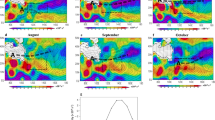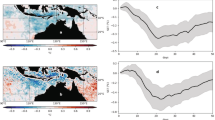Abstract
The El Niño Southern Oscillation (ENSO) creates strong variations in sea surface temperature in the eastern equatorial Pacific, leading to major climatic and societal impacts1,2. In particular, ENSO influences the yearly variations of tropical cyclone (TC) activities in both the Pacific and Atlantic basins through atmospheric dynamical factors such as vertical wind shear and stability3,4,5,6. Until recently, however, the direct ocean thermal control of ENSO on TCs has not been taken into consideration because of an apparent mismatch in both timing and location: ENSO peaks in winter and its surface warming occurs mostly along the Equator, a region without TC activity. Here we show that El Niño—the warm phase of an ENSO cycle—effectively discharges heat into the eastern North Pacific basin two to three seasons after its wintertime peak, leading to intensified TCs. This basin is characterized by abundant TC activity and is the second most active TC region in the world5,6,7. As a result of the time involved in ocean transport, El Niño’s equatorial subsurface ‘heat reservoir’, built up in boreal winter, appears in the eastern North Pacific several months later during peak TC season (boreal summer and autumn). By means of this delayed ocean transport mechanism, ENSO provides an additional heat supply favourable for the formation of strong hurricanes. This thermal control on intense TC variability has significant implications for seasonal predictions and long-term projections of TC activity over the eastern North Pacific.
This is a preview of subscription content, access via your institution
Access options
Subscribe to this journal
Receive 51 print issues and online access
$199.00 per year
only $3.90 per issue
Buy this article
- Purchase on Springer Link
- Instant access to full article PDF
Prices may be subject to local taxes which are calculated during checkout




Similar content being viewed by others
References
Glantz, M. H. Current of Change: Impacts of El Niño and La Niña on Climate and Society (Cambridge Univ. Press, 2001)
McPhaden, M. J., Zebiak, S. E. & Glantz, M. H. ENSO as an integrating concept in earth science. Science 314, 1740–1745 (2006)
Gray, W. M. in Meteorology over the Tropical Oceans (ed. Shaw, D. B. ) 155–218 (Royal Meteorological Society, 1979)
DeMaria, M. The effect of vertical shear on tropical cyclone intensity change. J. Atmos. Sci. 53, 2076–2087 (1996)
Dong, K. & Holland, G. J. A global view of the relationships between ENSO and tropical cyclone frequencies. Acta Met. Sin. 8, 19–29 (1994)
Wang, C. & Lee, S. Co-variability of tropical cyclones in the north Atlantic and the eastern North Pacific. Geophys. Res. Lett. 36, L24702 (2009)
Peduzzi, P. B. et al. Global trends in tropical cyclone risk. Nature Climate Change 2, 289–294 (2012)
Court, A. Tropical Cyclone Effects on California (National Oceanic and Atmospheric Administration Tech. Memo. NWS WR-159, 1980)
Chu, P. S. & Wang, J. Tropical cyclone occurrences in the vicinity of Hawaii: are the differences between El Niño and non-El Niño years significant? J. Clim. 10, 2683–2689 (1997)
Murakami, H., Wang, B., Li, T. & Kitoh, A. Projected increase in tropical cyclones near Hawaii. Nature Climate Change 3, 749–754 (2013)
Webster, P. J., Holland, G. J., Curry, J. A. & Chang, H. R. Changes in tropical cyclone number, duration and intensity in a warming environment. Science 309, 1844–1846 (2005)
Camargo, S. J., Sobel, A. H., Barnston. A. G & Ghil, M. Clustering of eastern north Pacific tropical cyclone tracks: ENSO and MJO effects. Geochem. Geophys. Geosyst. 9, Q06V05 (2008)
Collins, J. M. & Mason, I. M. Local environmental conditions related to seasonal tropical cyclone activity in the northeast Pacific basin. Geophys. Res. Lett. 27, 3881–3884 (2000)
Collins, J. M. The relationship of ENSO and relative humidity to interannual variations of hurricane frequency in the north-east Pacific Ocean. Pap. Appl. Geogr. Conf. 30, 324–333 (2007)
Balaguru, K., Leung, R. L. & Yoon, J.-H. Oceanic control of northeast Pacific hurricane activity at interannual timescales. Environ. Res. Lett. 8, 044009 (2013)
Toma, V. & Webster, P. J. Oscillations of the intertropical convergence zone and the genesis of easterly waves. Part I: diagnostics and theory. Clim. Dyn. 34, 587–604 (2010)
Wyrtki, K. Water displacements in the Pacific and the genesis of El Niño cycles. J. Geophys. Res. Oceans 90, 7129–7132 (1985)
Jin, F. F. Tropical ocean–atmosphere interaction, the pacific cold tongue, and the El Niño Southern Oscillation. Science 274, 76–78 (1996)
Jin, F. F. An equatorial ocean recharge paradigm for ENSO. Part I: conceptual model. J. Atmos. Sci. 54, 811–829 (1997)
Price, J. F. Metrics of hurricane–ocean interaction: vertically-integrated or vertically-averaged ocean temperature? Ocean Sci. 5, 351–368 (2009)
Lin, I. I. et al. An ocean coupling potential intensity index for tropical cyclones. Geophys. Res. Lett. 40, 1878–1882 (2013)
Balmaseda, M. A., Vidard, A. & Anderson, D. L. T. The ECMWF Ocean Analysis System: ORA-S3. Mon. Weath. Rev. 136, 3018–3034 (2008)
NOAA’s Tropical Prediction Center. http://www.nhc.noaa.gov/?epac
Meinen, C. S. & McPhaden, M. J. Observations of warm water volume changes in the equatorial Pacific and their relationship to El Niño and La Niña. J. Clim. 13, 3551–3559 (2000)
Clement, A. C., Seager, R., Cane, M. A. & Zebiak, S. E. An ocean dynamical thermostat. J. Clim. 9, 2190–2196 (1996)
Shay, L. K. & Brewster, J. K. Oceanic heat content variability in the Eastern Pacific Ocean for hurricane intensity forecasting. Mon. Weath. Rev. 138, 2110–2131 (2010)
Maue, R. N. Recent historically low global tropical cyclone activity. Geophys. Res. Lett. 38 L14803 http://dx.doi.org/10.1029/2011GL047711 (2011)
Latif, M. D. et al. A review of the predictability and prediction of ENSO. J. Geophys. Res. Oceans 103, 14375–14393 (2012)
Intergovernmental Panel on Climate Change (IPCC). Climate Change 2013: The Physical Science Basis. Contribution of Working Group I to the Fifth Assessment Report of the Intergovernmental Panel on Climate Change (eds Stocker, T. F. et al.) (Cambridge Univ. Press, 2013)
Lorenz, E. N. Empirical Orthogonal Functions and Statistical Weather Prediction (Massachusetts Institute of Technology Department of Meteorology, Statistical Forecasting Project Report 1, 1956)
Emanuel, K. A. The maximum intensity of hurricanes. J. Atmos. Sci. 45, 1143–1155 (1988)
Emanuel, K. A. Sensitivity of tropical cyclones to surface exchange coefficients and a revised steady-state model incorporating eye dynamics. J. Atmos. Sci. 52, 3969–3976 (1995)
Bister, M. & Emanuel, K. A. Dissipative heating and hurricane intensity. Meteorol. Atmos. Phys. 52, 233–240 (1998)
Leipper, D. F. & Volgenau, D. Hurricane heat potential of the Gulf of Mexico. J. Phys. Oceanogr. 2, 218–224 (1972)
Shay, L. K., Goni, G. J. & Black, P. G. Effects of a warm oceanic feature on Hurricane Opal. Mon. Weath. Rev. 128, 1366–1383 (2000)
Lin, I. I., Wu, C. C., Pun, I. F. & Ko, D. S. Upper-ocean thermal structure and the western North Pacific category 5 typhoons. Part I: ocean features and the category 5 typhoons’ intensification. Mon. Weath. Rev. 136, 3288–3306 (2008)
Goni, G. et al. Applications of satellite-derived ocean measurements to tropical cyclone intensity forecasting. Oceanography 22, 190–197 (2009)
Shay, L. K. & Brewster, J. K. Oceanic heat content variability in the eastern Pacific Ocean for hurricane intensity forecasting. Mon. Weath. Rev. 138, 2110–2131 (2010)
Zhao, M., Held, I. M., Lin, S. J. & Vecchi, G. A. Simulations of global hurricane climatology, interannual variability, and response to global warming using a 50-km resolution GCM. J. Clim. 22, 6653–6678 (2009)
Bengtsson, L., Hodges, K. & Esch, M. Tropical cyclones in a T159 resolution global climate model: comparison with observations and re-analyses. Tellus 59A, 396–416 (2007)
Bengtsson, L. et al. How may tropical cyclones change in a warmer climate? Tellus 59A, 539–561 (2007)
LaRow, T., Lim, Y.-K., Shin, D., Chassignet, E. & Cocke, S. Atlantic basin seasonal hurricane simulations. J. Clim. 21, 3191–3206 (2008)
Oouchi, K. et al. Tropical cyclone climatology in a global warming climate as simulated in a 20 km mesh global atmospheric model: frequency and wind intensity analysis. J. Meteorol. Soc. Jpn. 84, 259–276 (2006)
Rayner, R. et al. Global analyses of sea surface temperature, sea ice, and night marine air temperature since the late nineteenth century. J. Geophys. Res. 108 4407 http://dx.doi.org/10.1029/2002JD002670 (2003)
Moss, R. H. et al. The next generation of scenarios for climate change research and assessment. Nature 463, 747–756 (2010)
Acknowledgements
We thank P. Kim for providing the CMIP5 model’s outputs; M. Zhao for making his Atmospheric General Circulation Model outputs available; K. Emanuel for providing the potential intensity calculation program via his website; and C. Huang for help in data processing. This study was supported by US National Science Foundation grants ATM1034798 and ATM1406601, US Department of Energy grant DESC005110, US NOAA grant NA10OAR4310200, the China Meteorological Special Project (GYHY201206033) and the 973 Program of China (2010CB950404 and 2013CB430203). I.I.L.’s work is supported by Taiwan’s Ministry of Science and Technology under grants NSC 101-2111-M-002-002-MY2, NSC 101-2628-M-002-001-MY4 and 102R7803.
Author information
Authors and Affiliations
Contributions
F.F.J. conceived the idea. J.B. conducted most of the analysis. I.I.L. contributed to SSTPI and OCPI calculations and analysis. F.F.J. and J.B. contributed to writing the paper. All authors discussed the results and commented on the manuscript.
Corresponding authors
Ethics declarations
Competing interests
The authors declare no competing financial interests.
Supplementary information
Supplementary Information
This file contains Supplementary Tables 1-6 and Supplementary Figures 1-23. (PDF 3267 kb)
Rights and permissions
About this article
Cite this article
Jin, FF., Boucharel, J. & Lin, II. Eastern Pacific tropical cyclones intensified by El Niño delivery of subsurface ocean heat. Nature 516, 82–85 (2014). https://doi.org/10.1038/nature13958
Received:
Accepted:
Published:
Issue Date:
DOI: https://doi.org/10.1038/nature13958
This article is cited by
-
Spring Barents Sea ice loss enhances tropical cyclone genesis over the eastern North Pacific
Climate Dynamics (2024)
-
Changes of tropical cyclone size in three oceanic basins of the northern hemisphere from 2001 to 2021
Frontiers of Earth Science (2024)
-
Combined effects of ENSO and PDO on activity of major hurricanes in the eastern North Pacific
Climate Dynamics (2024)
-
Poleward migration as global warming’s possible self-regulator to restrain future western North Pacific Tropical Cyclone’s intensification
npj Climate and Atmospheric Science (2023)
-
Impact of tropical cyclones over the eastern North Pacific on El Niño–Southern Oscillation intensity
Climate Dynamics (2023)
Comments
By submitting a comment you agree to abide by our Terms and Community Guidelines. If you find something abusive or that does not comply with our terms or guidelines please flag it as inappropriate.



